
- Address : P.O. Box 11, Gannoruwa rd, Peradeniya, Sri Lanka
- E- Mail : director.hordi@doa.gov.lk
- Telephone :(+94) 081-2388011-12-13
- Fax :(+94) 081-2388234
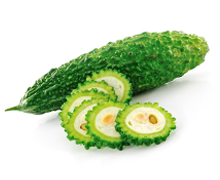
Bitter Gourd
Momordica Charantia
Bitter gourd is one of the popular vegetables in Sri Lanka. This crop is having high medicinal value with anti diabetic and anti cancer propertis. Because of higher nutricious and medicinal value this crop is becoming a higher demanding crop
Released Varieties
Climatic requirements/ Areas suitable for cultivation
Can be successfully cultivated up to above 1200 m of sea the level.
Soil
Well drained soil with more compost content and pH range from 5’5 – 7’5 is suitable.
Seed requirement
6 kg/ha
Nursery Management
Nursery can be prepared in sand trays or beds. Seeds can be directly placed in nursery with well supply of water and sunlight. Plnta can be directly transferred from nursery to field directly within 10 days. If need more days, plants can be transferred to pots for another two weeks.
Land preparation
Plough 30 cm depth and make fine soil structure with small particles and hills should be 30m x30 x30m in size prepared filled composition with compost and surface soil.
Planting
Maha season : October to November
Yala season : April, May
Year round cultivation can be allowed for suitable areas
3 seeds per hill in 2-3 cm depth for direct seeding with recommended spacing. Prepared nursery plants can be established in the field with better time selections.
Trellising: Three weeks after planting growing plants can be trained to a mesh or stakes. Lateral branches at lower parts of the plants can be pruned.
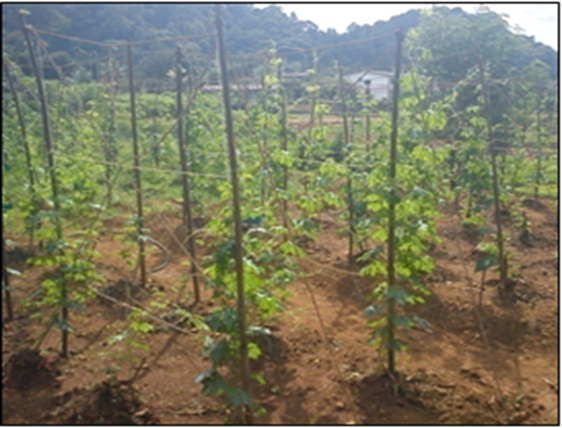
Spacing
1.5 m x 1 m
Fertilizer
Time of application | Urea kg/ha | TSP kg/ha | MOP kg/ha |
Basal | 75 | 200 | 60 |
After 4 weeks | 75 | – | 60 |
After 8 weeks | 75 | – | 60 |
Water supply
Need to keep crop with sufficient amount of soil water content. Water lodging will damage the plants. It is suitable to use soil cover to protect soil moisture during dry periods.
Pest Management
Disease Management
- Fungal diseases
- First appears as pale yellow spots on older leaves
- These spots enlarge as the white, fluffy mycelium grows over leaves surfaces
- Severely attacked leaves become brown and shrivelled and defoliation may occur
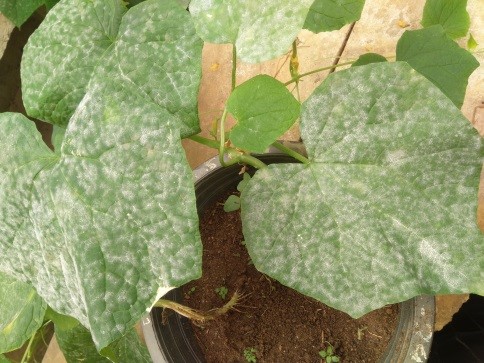 |
- Use recommended fungicides at initial stage of disease development (Refer: Pesticide recommendation DOA, 2019)
- Distraction of infected plant debris after harvest
Causal organism: Pseudoperonospora cubensis
Symptoms:
- Angular yellow spots that are limited by the leaf veins on the upper surface of the leaves.
- Leaves become chlorotic and finally necrotic and host plant cells die
Management:
- Use recommended fungicides at initial stage of disease development (Refer: Pesticide recommendation DOA, 2019)
- Distraction of infected plant debris after harvest
Causal organisms: Sclerotium spp., Fusarium spp.
Symptoms:
- Initially the plants show temporary wilting symptoms
- The leaves yellowing, loose turgidity and show drooping
- Eventually, the plant dies.
- Vascular bundles in the collar region become yellow or brown.
Management:
- Destroy infected plants with soil
- Improved drainage
- Use recommended fungicides at initial stage of disease development (Refer: Pesticide recommendation DOA, 2019)
Causal organisms: Didymella bryoniae
Symptoms:
- Lesions on leaves and fruit usually begin as spreading water-soaked areas
- The former these may have a chlorotic halo, become light brown and irregular in outline
- Dark cracked sunken lesions on fruit
- Plant collapse where sunken, girdling cankers
- Spots on stems often elongate into streaks and gummy exudates may occur from cracks
- Dark brown to black fruiting bodies (pycnidia) can be seen on fruit, stem, or leaf
Management:
- Crop debris should be ploughed deeply immediately after harvest to reduce fungus survival
- Use recommended fungicides at initial stage of disease development (Refer: Pesticide recommendation DOA, 2019)
- Bacterial diseases
- Sudden drooping of leaves
- Whole plant finally wilts
- Leaves become brown, dry
- Vascular discoloration (Brown)
- Permanent wilting
- Infected soil, water, plant debris, Nematodes and insects ,pruning, Weeds as host plants
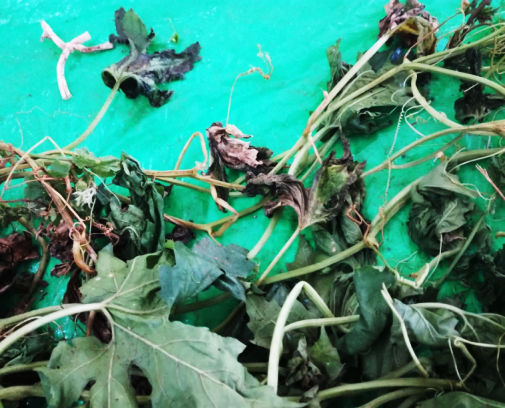 |
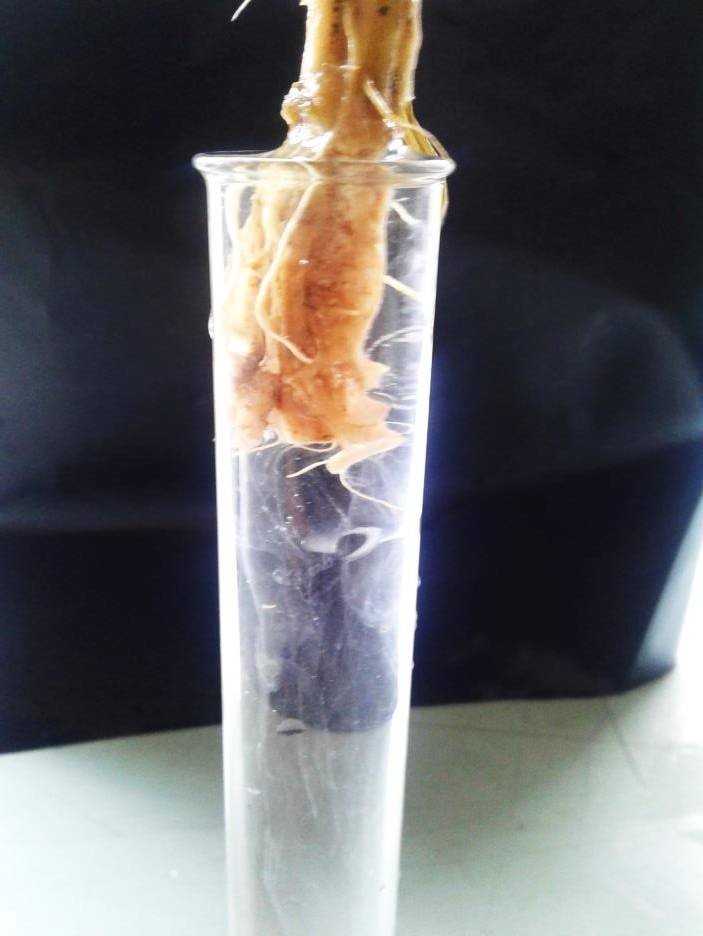 |
- Destroy infected plants with soil
- Crop rotation with non- susceptible crops (okra , maize)
- Mixed cropping with cruciferae crops
- Avoid movement of equipment from infected fields to non- infected fields
- Viral diseases
- upward curling, shortening, and distortion of leaves
- Plant stunted and fruits deformed.
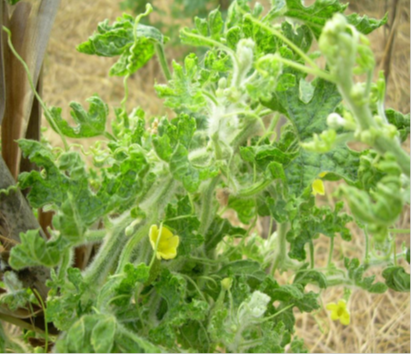 |
- Mosaic and mottling of leaves
- leaf distortion
- Malformation of fruits and reduction in fruit size
- In severe infections, oily patches on the fruit surface
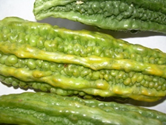 |
Symptoms:
- Green mottle, leaf deformation
- Green spot on fruits, turn bright yellow and decaying fruit
- fruit malformation.
Symptoms:
- Stunting, yellowing, necrosis (occasionally), mosaic, leaf deformations (blisters, shoe stringing)
- Fruit discolorations and deformations
- Pytoplasma Disease
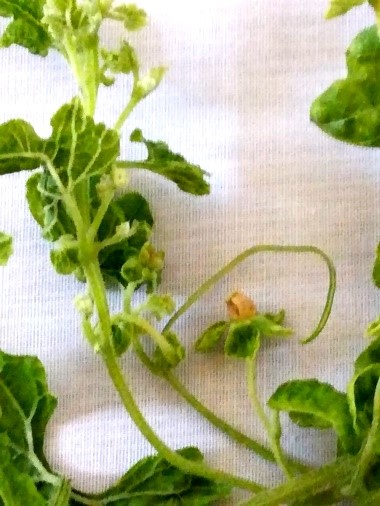 |
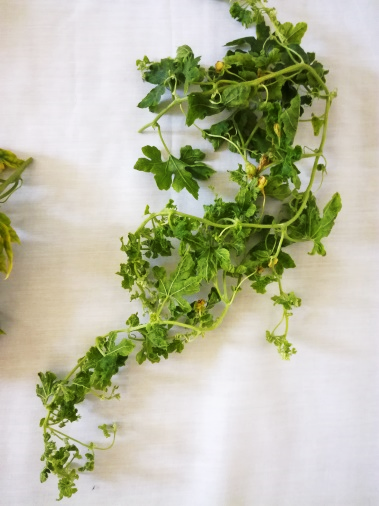 |
Harvesting
Yield
Average 20 t/ha for OP varieties and 20-30 t/ha for hybrid variety

